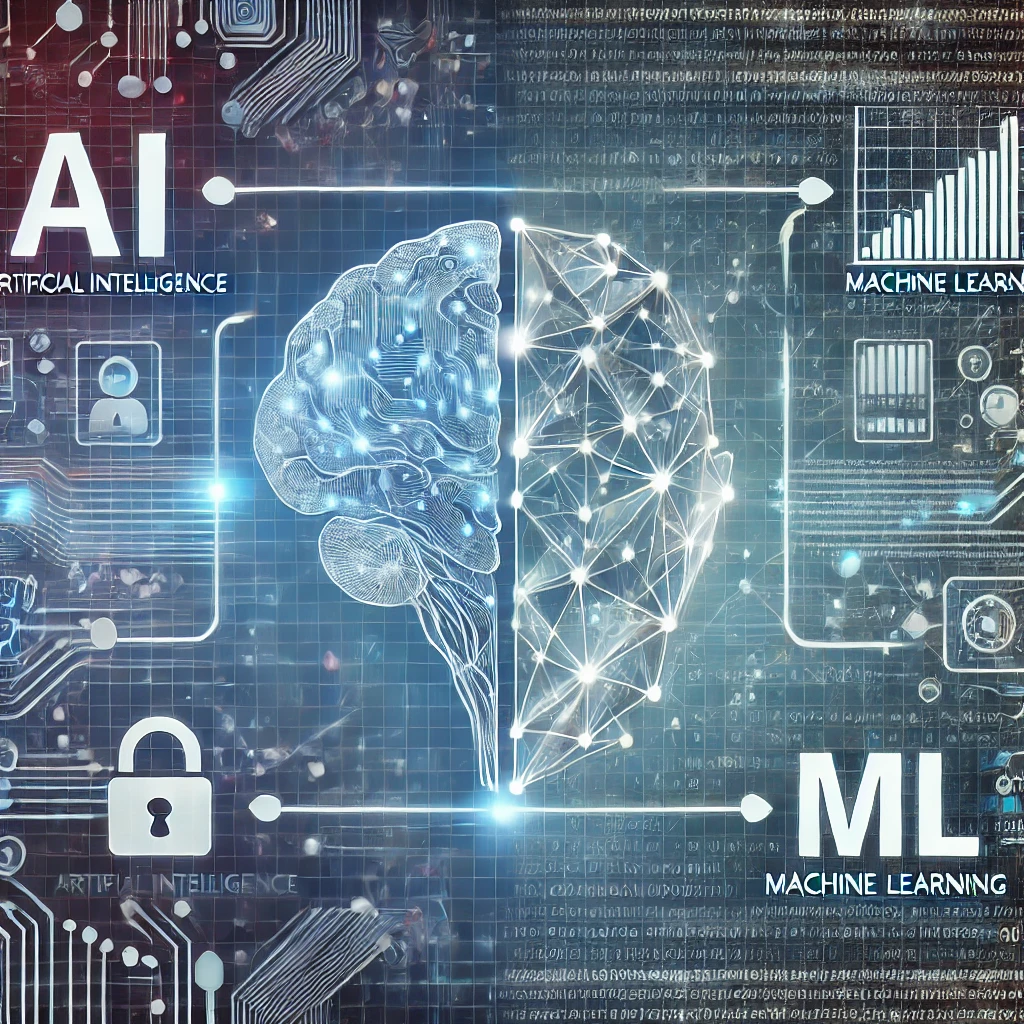Introduction to Machine Learning and Artificial Intelligence#

In the rapidly evolving landscape of technology, Artificial Intelligence (AI) and Machine Learning (ML) have emerged as transformative forces, reshaping industries, enhancing daily life, and pushing the boundaries of what machines can achieve. This book embarks on a comprehensive exploration of these fields, delving into their foundational methods, diverse applications, and the intricate interplay between them. This opening chapter serves as a roadmap, introducing the core concepts, key methodologies, and distinguishing features of AI and ML, setting the stage for deeper discussions in subsequent chapters.
🚀 Understanding Artificial Intelligence and Machine Learning#
🤖 What is Artificial Intelligence?#
Artificial Intelligence (AI) is a broad field of computer science focused on creating systems capable of performing tasks that typically require human intelligence. These tasks include:
Reasoning
Problem-solving
Understanding natural language
Perception
Creativity
AI aims to develop machines that can mimic cognitive functions, enabling them to interact intelligently with their environment and users.
“The science of making machines do things that would require intelligence if done by men.”
— Marvin Minsky
📊 What is Machine Learning?#
Machine Learning (ML) is a subset of AI that concentrates on enabling machines to learn from data and improve their performance over time without being explicitly programmed for specific tasks. ML algorithms:
Identify patterns
Make predictions
Make decisions based on data
This makes them indispensable for applications where data-driven insights are crucial.
🔗 The Relationship Between AI and ML#
“All machine learning is AI, but not all AI is machine learning.”
Machine Learning (ML): Focuses on creating models that learn from data to perform tasks such as prediction, classification, and optimization.
Artificial Intelligence (AI): Encompasses ML and a wider array of techniques, including rule-based systems, logical reasoning, and symbolic manipulation, aiming to create systems with comprehensive intelligent behavior.
🐴 The Working Horses of Machine Learning#
Machine Learning is powered by a diverse set of algorithms and techniques, each tailored to specific types of problems and data structures. These “working horses” form the backbone of ML applications across various domains.
1. Supervised Learning#
Supervised Learning involves training models on labeled datasets, where the input-output pairs are known. This approach is fundamental for tasks like classification and regression.
Linear Regression: Predicts continuous outcomes by fitting a linear relationship between input features and the target variable.
Logistic Regression: Used for binary classification tasks, estimating the probability of a categorical outcome.
Support Vector Machines (SVMs): Finds the optimal hyperplane that separates different classes in the feature space.
Decision Trees and Random Forests: Utilize tree-like models of decisions and ensembles of trees to improve prediction accuracy and control overfitting.
k-Nearest Neighbors (k-NN): Classifies data points based on the majority class among their nearest neighbors in the feature space.
Neural Networks (Basic Form): Comprise layers of interconnected neurons that process data through weighted connections, laying the groundwork for more complex architectures in AI.
2. Unsupervised Learning#
Unsupervised Learning focuses on uncovering hidden patterns or intrinsic structures in unlabeled data.
k-Means Clustering: Groups data into a predefined number of clusters based on feature similarity.
Principal Component Analysis (PCA): Reduces data dimensionality by transforming features into principal components that capture the most variance.
Autoencoders: Neural networks designed to learn efficient codings of input data, often used for dimensionality reduction and feature learning.
3. Reinforcement Learning#
Reinforcement Learning (RL) involves training agents to make sequences of decisions by interacting with an environment to achieve maximum cumulative rewards.
Q-Learning: A value-based RL algorithm that seeks to learn the quality of actions, denoted as Q-values, to inform decision-making.
Deep Q-Networks (DQN): Combines Q-Learning with deep neural networks to handle high-dimensional state spaces, enabling applications like game playing and robotics.
4. Deep Learning#
Deep Learning, a specialized subset of ML, employs complex neural networks with multiple layers to model intricate patterns in data, excelling in tasks such as image and speech recognition.
Convolutional Neural Networks (CNNs): Designed for processing grid-like data such as images, leveraging convolutional layers to detect spatial hierarchies.
Recurrent Neural Networks (RNNs): Suited for sequential data, capturing temporal dependencies through recurrent connections.
Long Short-Term Memory (LSTM) networks: A variant of RNNs that address the vanishing gradient problem, enabling the learning of long-term dependencies.
🧠 The Working Horses of Artificial Intelligence#
Beyond machine learning, AI encompasses a variety of non-learning-based techniques that enable intelligent behavior through predefined rules, logical reasoning, and structured knowledge.
1. Rule-Based Systems (Expert Systems)#
These systems use a set of if-then rules crafted by human experts to make decisions or solve problems within specific domains.
Example: A medical diagnosis expert system might use rules like:
If a patient has a fever and cough, then suggest checking for the flu.
If a patient reports chest pain and shortness of breath, then suggest checking for heart issues.
2. Search Algorithms#
Search algorithms explore possible solutions within a defined space to find the optimal one without learning from data.
A* (A-star) Algorithm: Finds the shortest path between nodes in a graph, widely used in navigation and pathfinding.
Minimax: Used in game theory for decision-making in two-player games like chess, evaluating the best move by minimizing the possible loss.
3. Knowledge Representation and Reasoning (KRR)#
KRR involves structuring information in a way that AI systems can utilize for logical reasoning and inference.
Example: Using First-Order Logic (FOL) to derive new truths from known facts:
All humans are mortal.
Socrates is a human.
Therefore, Socrates is mortal.
4. Planning and Scheduling#
AI systems employ planning techniques to determine sequences of actions that achieve specific goals.
STRIPS (Stanford Research Institute Problem Solver): Generates action sequences for agents or robots to reach target states, such as moving a robot to a designated location.
5. Symbolic AI (Good Old-Fashioned AI - GOFAI)#
Symbolic AI manipulates symbols and applies rules to solve problems, emulating human reasoning processes.
Example: Solving puzzles by symbolically processing known facts and applying logical rules, much like how humans approach riddles.
6. Automated Theorem Proving#
AI can be used to prove mathematical theorems by systematically applying logical rules without learning from previous theorems.
Example: Deductive reasoning systems that verify the validity of mathematical statements based on axioms and inference rules.
7. Constraint Satisfaction Problems (CSPs)#
CSPs involve finding values for variables that satisfy a set of constraints, used in various scheduling and resource allocation tasks.
Example: Assigning workers to shifts such that no one is scheduled for overlapping shifts and all shifts are adequately covered.
8. Logic-Based Agents#
These agents make decisions based on a knowledge base and logical inferences without learning from data.
Example: Using Prolog programming to create agents that evaluate facts against rules to determine actions.
9. Finite-State Machines (FSMs)#
FSMs model systems that transition between states based on inputs, following predefined conditions without adaptation.
Example: An elevator control system moving between floors based on button inputs, transitioning states like “idle,” “moving up,” or “moving down.”
10. Deterministic Algorithms#
These algorithms follow a fixed set of rules to produce the same output for a given input every time, without learning or adaptation.
Example: Sorting algorithms like quicksort or mergesort that arrange data in a specific order through a defined procedure.
🆚 Distinguishing Machine Learning from Artificial Intelligence#
While Machine Learning is a critical component of Artificial Intelligence, understanding their distinctions is essential for grasping the broader AI landscape.
🔍 Scope#
Machine Learning (ML): Focuses on creating models that learn from data to perform tasks such as prediction, classification, and optimization.
Artificial Intelligence (AI): Encompasses ML and a wider array of techniques, including rule-based systems, logical reasoning, and symbolic manipulation, aiming to create systems with comprehensive intelligent behavior.
🎯 Approach#
ML: Employs empirical, data-driven methods where models improve through exposure to data.
AI: Utilizes both empirical methods (like ML) and symbolic, logic-based approaches that rely on predefined rules and reasoning.
🛠️ Techniques#
ML: Relies on algorithms like linear regression, SVMs, neural networks, and decision trees.
AI: Incorporates ML techniques alongside expert systems, knowledge representation, search algorithms, and symbolic reasoning.
🎓 Goals#
ML: Aims for tasks that benefit from pattern recognition and data-driven insights, enhancing prediction accuracy and decision-making based on historical data.
AI: Seeks to emulate a broader spectrum of human cognitive abilities, including reasoning, problem-solving, language understanding, and autonomous action.
🌟 The Journey Ahead#
This book will navigate through the intricate realms of Machine Learning and Artificial Intelligence, dedicating individual chapters to each method and technique outlined in this introduction. By exploring both learning-based and non-learning-based approaches, readers will gain a holistic understanding of how intelligent systems are designed, developed, and deployed across various applications.
Whether you’re a student, practitioner, or enthusiast, this journey will equip you with the knowledge and insights to harness the full potential of ML and AI in solving complex real-world problems.
🌐 Stay Curious
As we delve deeper into each method in the upcoming chapters, we will examine their theoretical foundations, practical implementations, and real-world applications. This structured approach ensures a comprehensive grasp of both the breadth and depth of Machine Learning and Artificial Intelligence, empowering you to contribute to and innovate within these dynamic fields.

Setting Up Your Jupyter Book Environment#
Before we dive into the fun stuff, let’s set up your environment for running the Jupyter Book locally. Here’s how to get everything in place:
Activate your Jupyter Book environment:
conda activate jb
Install Jupyter Book and dependencies:
pip install -U jupyter-book conda install -c conda-forge jupyter-book
Create and build your Jupyter Book: Remember, you should not be inside the
mybooknamefolder when running this:jb create mybookname jb build mybookname
Push to GitHub Pages: To publish your book, make sure you’re inside the
mybooknamefolder:git clone https://github.com/mikenguyen13/mlpy cd mybookname pip install ghp-import ghp-import -n -p -f _build/html/
Once the book is built, it will automatically be published to GitHub Pages for easy access.
Table of Contents#
Here’s a table of contents for this book, which will update as we build new chapters and sections:
Theory
Industry Applications
- Credit Score Model
- Risk Minimization
- Risk Minimization with Overdue Balance
- Credit Approval
- Credit Adjustment
- Firm Valuation
- Financial Fraud Detection
- Create feature names
- Create DataFrame
- Display class distribution
- Approximate Nearest Neighbors
- Multi-Armed Bandits
- Data Anonymization Techniques for Geospatial Data
- Split Samples in Time Series
